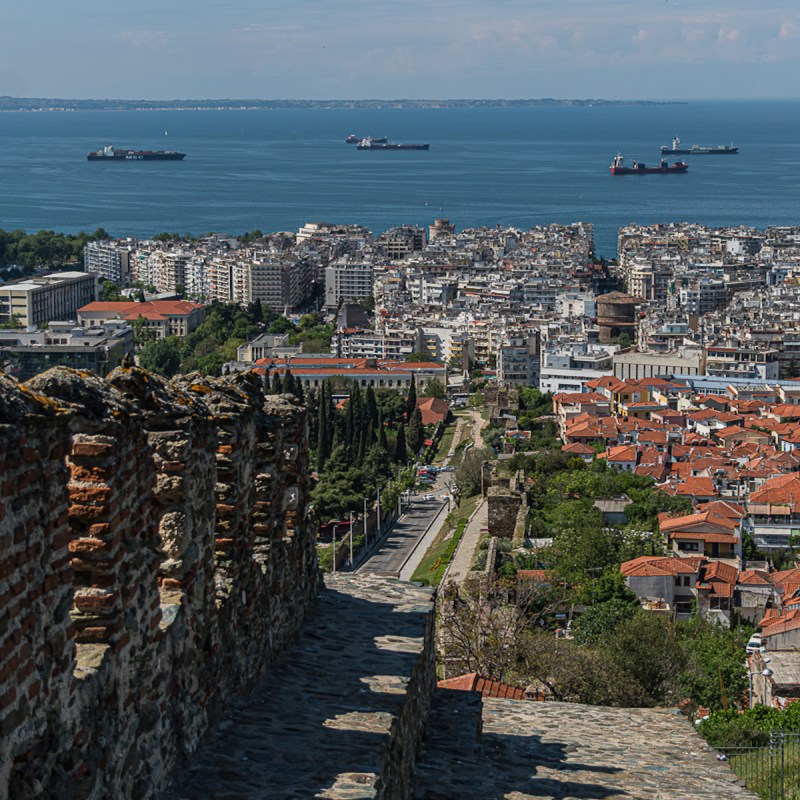
Thessaloniki, capital of the region of Central Macedonia and Greece’s second largest city, is a shimmering jewel on the Thermaic Gulf. She basks in the Aegean sun, beckoning all to come and partake of her many delights. Renowned for rich history, stunning architecture, exquisite cuisine, and friendly citizens, this enchanting destination offers visitors many unique one-of-a-kind experiences.
Videos by TravelAwaits
The city enthralled my husband and me with its timeless allure. We walked miles each day, exploring monuments, museums, and other points of interest. Then, we rested our feet at an outdoor café in Thessaloniki’s bustling Aristotelous Square and engaged in the popular pastime of people watching.
Totally fascinated and thoroughly exhausted, we settled into our comfortable room at the Bristol Capsis Historical Boutique Hotel. The next morning, following a hearty hotel buffet breakfast, we were ready to do it all again. Although Thessaloniki is overflowing with fascinating things to see and do, these are the nine we recommend as an introduction to this vibrant and awe-inspiring city.
We are grateful to Pass Partout – Tourism Marketing and Bristol Capsis Historical Boutique Hotel for their generous support and assistance during our Thessaloniki visit. However, all opinions are entirely my own.
1. The Archaeological Museum Of Thessaloniki
Showcasing the rich history and culture of the region, from prehistoric times to late antiquity, the Archaeological Museum is one of the most important museums in Greece.
This spacious, thoughtfully laid out museum houses a wealth of artifacts, including priceless pottery, magnificent jewelry, sculptures, coins, and mosaics. These and other artifacts combine to trace the development of Macedonian civilization and that of Greece.
Among other treasures, my husband and I were in awe of the gold salvaged from the royal tombs of Vergina and the Derveni papyrus — the oldest surviving book in Europe.

2. Museum Of Byzantine Culture
Discover another important chapter of Thessaloniki’s story at the Museum of Byzantine Culture. The extensive collection, spanning from the 4th to the 15th century, consists of more than 3,000 objects. Icons, frescoes, manuscripts, textiles, and other artifacts convey the history, art, and splendor of the Byzantine Empire.
The exhibits were grouped in thematic sections representing various aspects of Byzantine life. This arrangement made it easy for us to gain a basic understanding of how the society functioned in the areas of religion, politics, economy, and culture.

3. White Tower
Standing tall on the waterfront, the White Tower is Thessaloniki’s most recognizable landmark. The Ottomans constructed the tower in the 15th century and it served as the city’s fortifications as well as a prison and place of execution. Today, it houses a museum that tells the story of Thessaloniki through various multimedia exhibits on six levels.
We climbed the stairs, stopping on all six floors. Each display focused on a different period and theme, such as the Roman, Byzantine, Ottoman, and modern eras. Reaching the top, we were rewarded with stunning panoramic views of Thessaloniki and the sea sparkling in the sun.
You can purchase a pass that gives you access to the above museums, as well as other attractions.
4. Jewish Museum Of Thessaloniki
Thessaloniki has an intriguing Jewish history spanning 2 millennia. Romaniote Jews, who had been living in Greece since ancient times, formed a vibrant and diverse community. They welcomed Jewish arrivals during Roman times, Sephardic Jews fleeing Spain in the 15th century, and Ashkenazi Jews escaping the pogroms and persecution of the 19th and 20th centuries in Eastern Europe.
Through the centuries, the Jewish community made substantial contributions to Thessaloniki’s culture and economy. At its peak, the city had more than 30 synagogues and was known as the “Mother of Israel.” During the Nazi occupation of WWII, more than 56,000 Thessaloniki Jews were deported to the Auschwitz-Birkenau extermination camps. Fewer than 2,000 returned. Two synagogues now serve Thessaloniki’s greatly diminished Jewish community.
We found the Jewish Museum of Thessaloniki in a former city center bank building. Artifacts, documents, photographs, and testimonies captured the religious traditions, social life, economic activities, and artistic expressions of Thessaloniki’s Jewish community from ancient times to the present.
The Holocaust Section was especially heart-wrenching and disturbing. Obviously, the curators had poured much care and consideration for the truth into assembling the exhibit.

5. Rotunda Of Galerius
Originally built as a mausoleum for Roman Emperor Galerius, Thessaloniki’s Rotunda didn’t take long to explore. But this brief interlude packed a sizable punch. The Roman and Byzantine architecture combined to create a treat for the eyes and some welcome shade on a hot afternoon.
Intricate mosaics adorned the grand interior and we marveled at the workmanship dating back nearly 2 millennia. A fine example of Thessaloniki’s multicultural heritage, the Rotunda gave our saturated brains a respite, while gently handing us yet another piece of the Thessaloniki historical puzzle.
Since it was nearby, we walked over to and around the Arch of Galerius. It struck us how these monuments, dating back to the Roman and Byzantine periods, reflected the architectural styles and influences of the eras that are so prominent in Thessaloniki’s cultural framework.
6. The Waterfront Promenade
In an effort to wind down from our long but exhilarating days, we treated ourselves to leisurely strolls along the waterfront promenade, passing tavernas, cafés, and smiling people also partaking in the early evening cool-down. We enjoyed tranquil views of the Thermaic Gulf, as well as glimpses of the White Tower.
It felt as if we had one foot firmly planted in the past and the other in the present. We knew then we had fallen under Thessaloniki’s spell, because this sensation seemed perfectly natural.

7. Historic Churches
The Greek Orthodox Church plays a prominent role in Greek culture and Thessaloniki is home to several of the most impressive churches in Greece. The interior of Hagia Sophia was breathtaking, with its stunning mosaics and frescoes that transported us back to the days of the Byzantine Empire. Another architectural gem was Agios Dimitrios, dedicated to the city’s patron saint and awe-inspiring both inside and out.
Thessaloniki has more stunning churches than most can pack into one visit. But considering the wonders each church holds, you can’t go wrong, even if you manage to see only one.

8. Ano Poli
A climb up winding streets led to Ano Poli (Upper Town), the city’s old town. A maze of narrow cobblestone alleys, traditional colorful houses, quaint squares, and picturesque Byzantine churches greeted us, along with the imposing Byzantine walls and the breathtaking views they offered.
After catching our breath and soaking up the authentic atmosphere of Ano Poli, we continued our climb up to the Castle of Thessaloniki, located on a hill above the ancient neighborhood. The castle was built in 316 B.C. and the existing walls date back to the 4th century A.D. Our exhaustion from the climb was replaced with spectacular views of the city, the port, and the Aegean Sea from atop the Trigonian (Chain) Tower.

9. The Phenomenal Flavors Of Thessaloniki
To our delight, Thessaloniki was a food lover’s paradise influenced by various cultures and cuisines. Our first stop was the bustling Kapani Market, where we indulged our senses in fresh produce, spices, and local specialties.
Thessaloniki was an abundant grazing ground, so we opted for snacks and street food during the day, and tiny family-run restaurants — unpronounceable names, limited menus, and no websites — for dinner. Our favorites included tender calamari, grilled octopus, spicy meatballs, gyros, mpougatsa (a savory cheese or meat pie), creamy stewed fava beans, and smoky eggplant dishes. For dessert, we usually indulged in the classic flaky baklava, washed down with Greek coffee. And not a day went by without a fresh Greek salad dressed in some of the best olive oil we’ve ever tasted.
Thessaloniki is a captivating concoction of old and new. No matter where you stand or what you touch, you come into contact with a piece of the city’s history. At the same time, Thessaloniki invites you to enjoy modern amenities and participate in its vibrant nightlife. Ancient ruins, a first-rate food scene, and a welcoming vibe make exploring this Greek gem an unforgettable adventure. In fact, you could continue the adventure by making Thessaloniki your first stop on a Macedonia road trip.
Related Reading:

